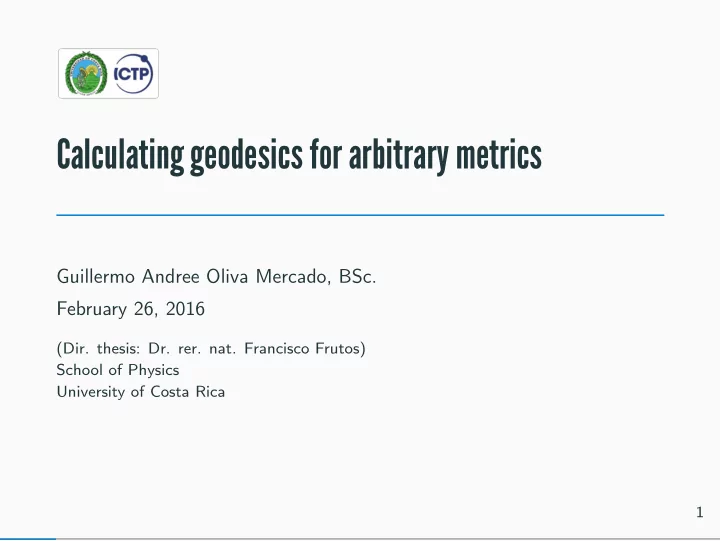

Calculating geodesics for arbitrary metrics Guillermo Andree Oliva Mercado, BSc. February 26, 2016 (Dir. thesis: Dr. rer. nat. Francisco Frutos) School of Physics University of Costa Rica 1
1. Description of the problem 2. Structure of the program 3. Example inputs and results 2
Description of the problem
Compact/massive objects and bending of the light • Gravitational lenses • Emission from accretion disks 3
Mathematical setup • Metrics • Describe the spacetime for a given configuration of matter–energy • Solutions of Einstein Field equations • Hard to find! • Geodesics • Trajectories of light and massive particles • We are concerned with light only • Calculated with geodesic equations • Geodesic equations • Second order differential equation • Contains derivatives of the metric • Initial conditions determine the type of geodesic 4
Initial conditions 5
Structure of the program
General scheme Geodesic equations Metric X General Relativity for metric X main numeric: initial Numeric stuff Output files condition variation for 1 geodesic Statistical analysis Visualization sage python gnuplot text file module input/output file 6
Decisions I had to make • Languages • Sage: symbolic calculations • Python: numeric / statistical / plotting / gluing • Gnuplot: some plotting • Input / output • Library for GR calculations = ⇒ input is a script • Library for geodesic calculations = ⇒ input is a script • Easy extension of the program to solve similar problems • Output are plots • Validation • Used known metrics (Minkowski, Schwarzschild) 7
Examples of input and results
Input for the symbolic part I load "equations.sage" var(’x0 x1 x2 x3 v0 v1 v2 v3 M a q’) params=[M,a,q] . . . (some parameter definitions) frutos = SpaceTime() frutos.metric = Tensor([oneForm(),oneForm()],4) frutos.metric[0,0] = exp(-2*psi)*(a^2*(sin(x2))^2 - delta)/rh^2 frutos.metric[1,1] = rh^2*exp(2*ji)/delta frutos.metric[2,2] = rh^2*exp(2*ji) frutos.metric[3,3] = exp(2*psi)*sin(x2)^2*(( x1^2 + a^2 )^2 - a^2*delta*(sin(x2))^2)/rh^2 frutos.metric[0,3] = -2*M*a*x1*(sin(x2))^2/rh^2 frutos.metric[3,0] = frutos.metric[0,3] frutos.conn = Tensor([tangent(),oneForm(),oneForm()],4) christoffel(frutos.conn,frutos.metric,[x0,x1,x2,x3]) eqs = generate_equations(frutos.conn,[x0,x1,x2,x3],[v0,v1,v2,v3]) Write(frutos) 8
Input for the numerical part from geodesics import * for k in arange(-12,12,0.5): pos_cart = (10,0,k) r,theta,phi = to_spherical(*pos_cart) vel = (-sin(theta)*cos(phi),-cos(theta)*cos(phi)/r,sin(phi)/(r*sin(theta))) state = [0,r,theta,phi,0,vel[0],vel[1],vel[2]] state[4] = calculate_v0(state) generate_geodesics(lam=0,state,dlam=0.05,limits=[40,2,20]) 9
Example plots 10 5 0 -5 a = 0 a = 0.3 a = 0.6 a = 0.9 -10 -10 -5 0 5 10 10
11
12
References Oliva, A., Frutos, F., Bonatti, J., González, K. (2016) . A numerical study of a Kerr-like metric. http://gandreoliva.org/papers/simmac16-a.pdf (not yet published). Oliva, A., Bonatti, J., Cordero, I. & Frutos, F. (2015) . A Visualization of Null Geodesics for the Bonnor Massive Dipole. Revista de Matemática: Teoría y Aplicaciones 22(2), 255-264. Frutos, F. (2015). New approximate Kerr-like metric with quadrupole. ArXiv:1509.03698v1 (not yet published) 13
Recommend
More recommend